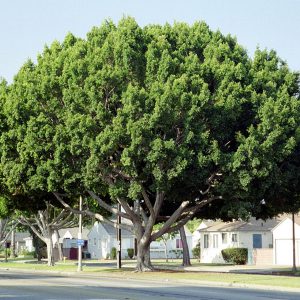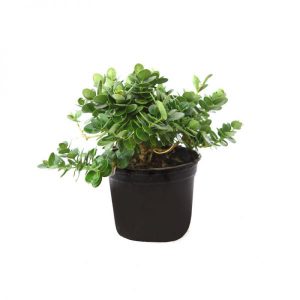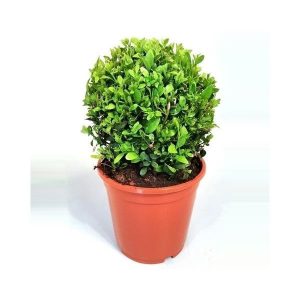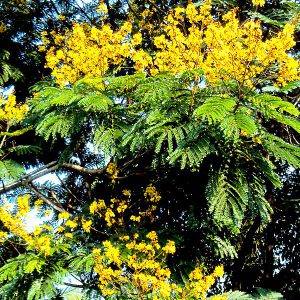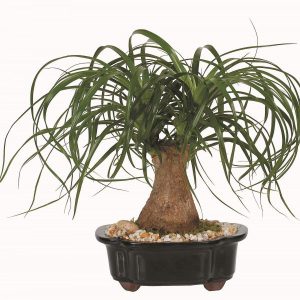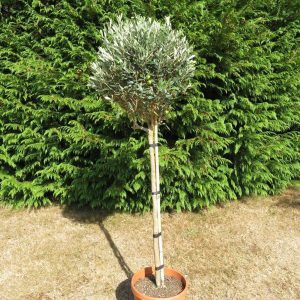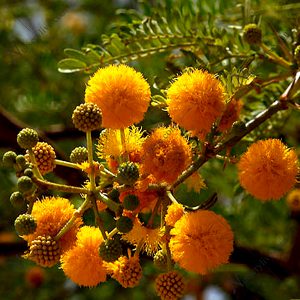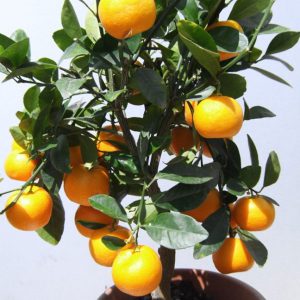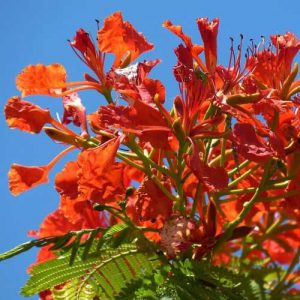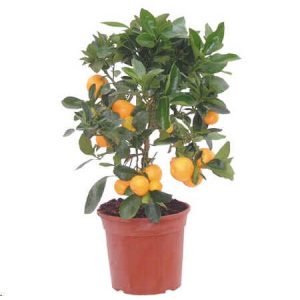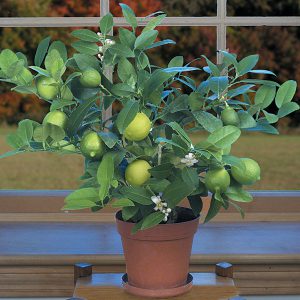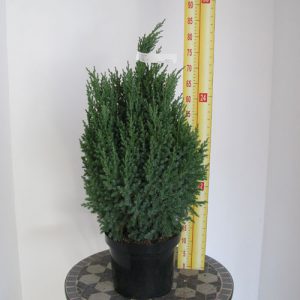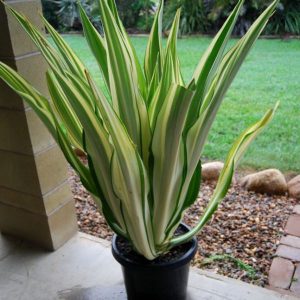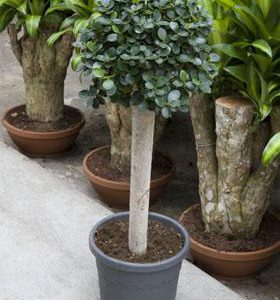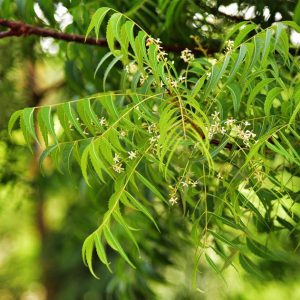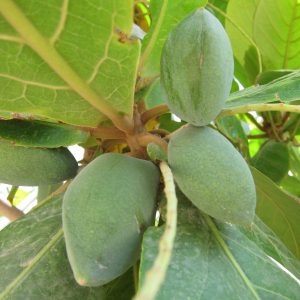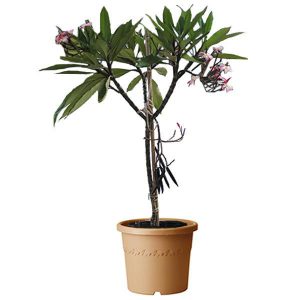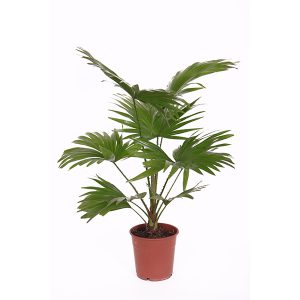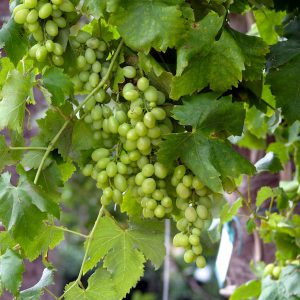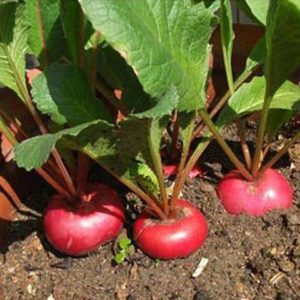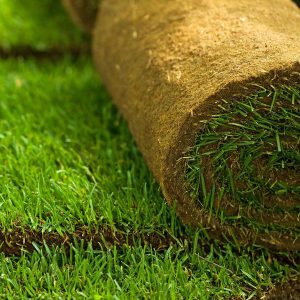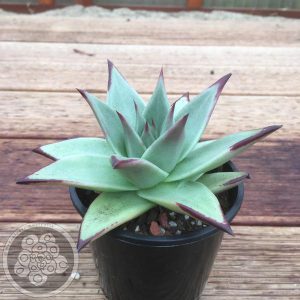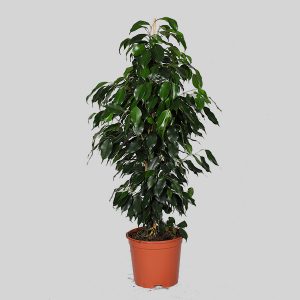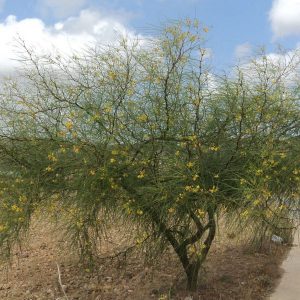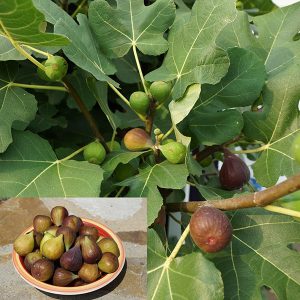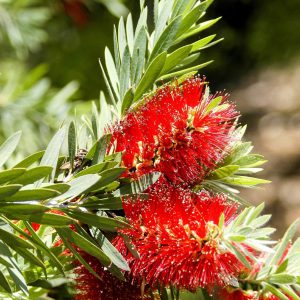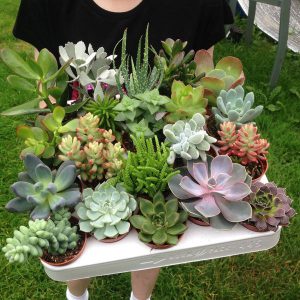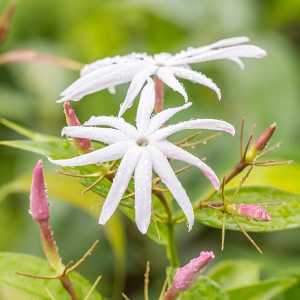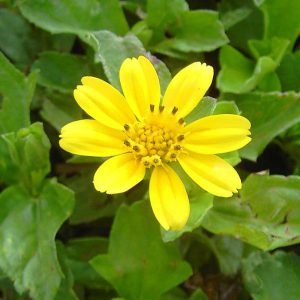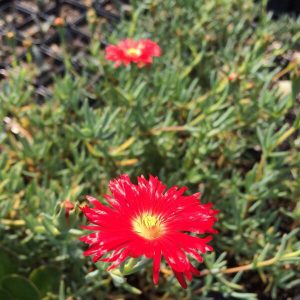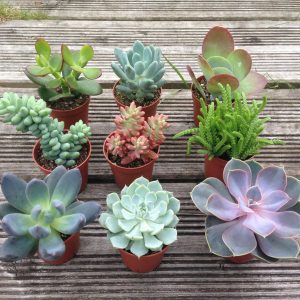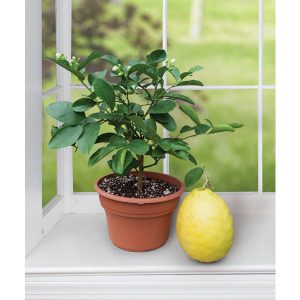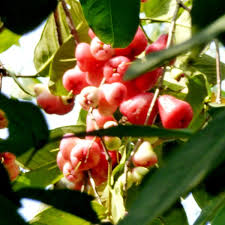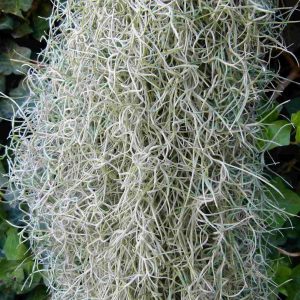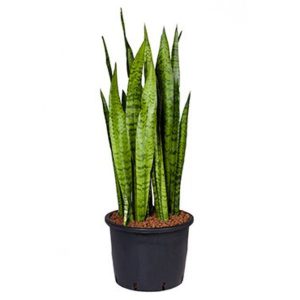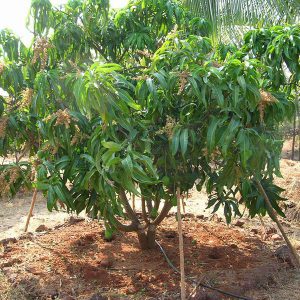Outdoor Plants
Banyan tree
Grow the banyan tree in an area that is large enough to accommodate its eventual size – up to 100 feet in height with a spread that may take up several acres. As a houseplant, place the banyan tree in an area with partial shade or in bright light. Choose one or the other and then don’t move it or it may end up dropping its leaves.
Water the mature outdoor banyan tree only during prolonged periods of drought. Indoors, let the soil dry out and then place the plant under the faucet, turn it on to a steady drip, and saturate the soil. Another way to ensure that the soil is evenly saturated is to place the pot in a shallow pan of water. Add more water to the pan as the soil absorbs it, until the top of the soil is wet.
AED 1,900.00Add to cart
caribbean trumpet tree (tabebuia argenitna)
The Tree of Gold is one of the most spectacular of flowering trees, especially when grouped. Flowering is brief, intense and is usually started and completed by all trees in close unison. It is planted as an ornamental and persistent tree. It is good for planting along avenues and in parks and home gardens.
This species grows well in a wide variety of soils and requires little maintenance
AED 450.00Add to cart
Buxus sempervirens
This widely used genus is prized for its evergreen foliage and its ability to withstand heavy pruning. The yellow-green flowers are insignificant. Buxus has been used in hedging, topiaries, and parterres for centuries.
Noteworthy CharacteristicsOpposite, glossy rounded to lance-shaped leathery leaves. Variegated forms exist.
CareGrow in any soil, preferably in part shade. Tolerates full sun if the soil is moist. Prune in late spring and summer; supply fertilizer after any heavy pruning to aid in regeneration.
PropagationRoot semi-ripe cutttings in summer. Graft in winter.
AED 370.00Add to cart
Yellow panciana (peltophorum)
These trees are fast growers to 40 feet. No two grow alike, but the general rule of thumb is to expect a broad-spreading crown. Place the tree in an area of full to part sun with this eventual growth in mind.
Peltphorums are cold tolerant, growing anywhere in South Florida. It’s the only cold hardy tree of the three look-alikes that include jacaranda and royal poinciana.
AED 350.00Add to cart
Ponytail palm (nolina palm)
- Use a fast draining soil, such as a cacti and succulent potting mix. If you have potting soil, sand, and perlite already on hand, you can create your own desert soil mixture: Simply mix 1 part potting soil, 1 part perlite, and 1 part sand.
- Select a pot that has a hole in the bottom, so that excess water can be drained off. Ponytail palms do not like to sit in moist soil for very long.
- Use a clay pot if possible; the porous material will absorb some of the water, drying out the soil more quickly (a good thing for cacti and succulents).
- Ponytail palms prefer to have as much light as possible, so place the plant in a bright location.
AED 335.00Add to cart
Olive tree (olea europea)
The olive tree is an ancient cultural and characteristic plant of the Mediterranean, which comes from a Mediterranean wild family, the Olea europaea var sylvestris. The farming of the tree goes back many millennia and probably took place in the Eastern Mediterranean. There are about 300 different olive varieties grown worldwide for the production of table olives and olive oil. These products represent a very important branch of industry in the Mediterranean countries, particularly Spain, Italy and Greece.
AED 300.00Add to cart
Needle bush (acacia farnesiana)
Acacia farnesiana thrives in dry localities and it is drought hardy and fire resistant. It can be found at elevations between sea level and 1300 m. The species is reported to exhibit tolerance to drought, high pH, heat, low pH, salt, sand, and slope. It forms symbiotic relation with Rhizobium allowing it to grow in nitrogen poor soils. Thrives on poor, dry soils but favors deeper, moister, more fertile clayey soils.
Acacia farnesiana origin is in Mexico and Central America. This species was given its name since it was introduced to Europe in the 17th century to the Farnese Gardens, created in 1550 on the northern portion of Palatine Hill in Rome, Italy, by Cardinal Alessandro Farnese, and was the first private botanical gardens in Europe. Since then it spread and became naturalized in many of the world’s subtropical and tropical arid lands
AED 280.00Add to cart
Citrus Mitis
Citrus mitis is an indoor orange tree very well suited to living inside our heated homes.
Citrus mitis, also called calamondin, is a small fruit shrub that produces edible fruits, but they’re so acidic that they’re hard to digest.
Indoors, simply set your citrus mitis in a well-lit spot but avoid direct sunlight during the hottest hours.
Also avoid setting it right near a radiator.
If you can, it is good to bring your Citrus mitis outdoors after any risk of freezing has disappeared, from spring until the end of summer, either on a balcony, terrace, or garden deck.
AED 260.00Add to cart
Royal poinciana -delonix regia
Given proper care, royal poinciana (Delonix regia), also known as flamboyant tree, peacock flower and flame tree, celebrates late spring with color. Flame-red clusters of 5-inch blooms drench the gray-barked branches before their foliage unfurls. Fernlike leaves soon follow, and the show continues through midsummer. Long, ornamental seedpods replace blooms by season’s end. The tree reaches 30 to 40 feet tall and spreads 50 or more feet, with its branches forming an umbrella of filtered shade. Hardy in U.S. Department of Agriculture plant hardiness zones 10 through 12, royal poinciana has no serious disease, insect or other problems when its basic care needs are met.
AED 250.00Add to cart
Pomelo (citurs maxima)
Like other citrus fruits, pomelos are high in vitamin C. They are generally eaten as a fresh fruit, and they store well. They have long been popular in Asia, especially China, Indonesia, and Thailand, but are increasingly found in specialty markets in the U.S. as well. The juice is also used in various beverages (both alcoholic and non), and the peel may be candied. Traditional medicinal uses of the fruit include treatment of coughs, fevers, and gastrointestinal disorders. The aromatic flowers are picked and processed into perfume in Vietnam, and the wood, which is heavy and hard-grained, used for making tool handles.
AED 250.00Read more
Citurs clementine
Clementines (Citrus reticulata “Clementine”) are beautiful lush green trees that produce juicy citrus fruit in mid to late fall. They grow well outdoors in U.S. Department of Agriculture plant hardiness zones 9 through 11, but also can be potted and grown indoors elsewhere. If you live where it doesn’t get below 40 degrees Fahrenheit, care for the clementine tree in a pot until it grows to 3 feet tall, then transplant it outside.
AED 250.00Read more
Juniperus chinensis outdoor
- Easily transplanted
- prefers moist, well-drained soil, but very adaptable
- full sun
- pH adaptable
- once established little maintence required
AED 250.00Read more
furcraea foctida
Growing F. foetida is as simple a matter as keeping its soil drained and making sure it receives an adequate amount of sunlight. These plants are drought-resistant and need to be watered only infrequently—in the wild, they often grow on rocks or cliffs—and they prefer full sun. If you’re growing them in pots rather than your garden, make sure the soil stays fairly dry and repot if necessary.
AED 240.00Add to cart
ficus panda
Ficus (genus Ficus), a group of about 900 species of trees, shrubs, and vines, commonly called figs. Native primarily to tropical areas of East Asia, they are distributed throughout the world’s tropics. Many are tall forest trees that are buttressed by great spreading roots; others are planted as ornamentals.
The always popular ficus tree is a member of the fig family and perfect for caring for as a houseplant. There are several varieties of this plant that are grown as houseplants. Among these are the ficus benjamina or weeping fig, the ficus lyrata or fiddle head fig, and the ficus elastica decora or rubber tree. The Bodhi tree, under which the Buddha achieved enlightenment, is believed by many to have been a ficus religiosa. The most popular as an indoor tree is the ficus benjamina.
AED 230.00Add to cart
Neem tree(azadirachta indica)
The neem tree (Azadirachta indica) has caught the attention of gardeners in recent years for the benefits of its oil, a safe and effective herbicide. However, that’s just the beginning of the story. This versatile plant, native to tropical India and Asia, is a valuable tree with many uses. Read on for neem tree information, including neem tree benefits and uses
AED 215.00Add to cart
Terminalia Catappa
- Terminalia catappa is a large tree. It grows to 35 metres tall.
- This tree is wonderful for giving shade…it is a fast grower.
- A decidious tree it can shed its leaves twice a year, the leaves turn into colours of red, copper, gold.
- The tree first drops its leaves when it reaches 3-4 years old.
- The fruits are almond-shaped and green turning brown to purple when ripe.
- In case you do not want the tree to grow very tall – you can cut off the vertical growing stem.
- The tree will then spread sideways.
AED 210.00Add to cart
Plumeria
Plumeria flowers are most fragrant at night in order to lure sphinx moths to pollinate them. The flowers yield no nectar, however, and simply trick their pollinators. The moths inadvertently pollinate them by transferring pollen from flower to flower in their fruitless search for nectar. Insects or human pollination can help create new varieties of plumeria. Plumeria trees from cross pollinated seeds may show characteristics of the mother tree or their flowers might just have a totally new look.
Plumeria species may be propagated easily by cutting leafless stem tips in spring. Cuttings are allowed to dry at the base before planting in well-drained soil. Cuttings are particularly susceptible to rot in moist soil. One optional method to root cuttings is applying rooting hormone to the clean fresh-cut end to enable callusing. Plumeria cuttings could also be propagated by grafting a cutting to an already rooted system.
AED 210.00Add to cart
Livingstonia
Chinese Fan Palm is a BIG plant with sprawling fanlike fronds that grow up to 2 ft (60 cm) across.
When mature, this palm is a picture of elegance. Its broad, fan-shaped foliage is carried on tall stems, making it a graceful ornamental for the home. Treat it right and you’ll enjoy your Chinese Fan Palm for many years.
Put it in a bright spot, but out of direct sunlight. You’ll find that this palm is adaptable to average home temperatures and is easy to please.
Older fronds may turn brown. Cut off old fronds near the trunk, using sharp pruners.
Brown leaf tips are fairly common on indoor palms,
AED 205.00Add to cart
Vitis vinif era (graape vine)
Choose a location for Grapes where they’ll receive sun all day long for the entire growing season, but avoid low-lying areas where cold air settles. In most parts of this country, a sunny south-facing slope is ideal. Good air circulation is important, too, as it reduces fungal diseases such as powdery mildew.
AED 200.00Read more
Reindeer moss
Provide your reindeer moss with good quality air. Reindeer moss does not grow roots, and draws minimal nourishment from host plants like trees. It depends on the air for almost all of its nutrients, and will not sustain itself in highly polluted areas.
AED 200.00Add to cart
Radish red
Radishes mature incredibly quickly (with some varieties taking only 3 weeks from seed to maturity), and they are very hardy. Their peppery flavor adds a kick to soups and salads, and they take up very little space in the garden. To begin successfully growing radishes, you’ll find the following instructions most helpful.
AED 200.00Read more
natural grass carpet roll
Thorough watering encourages your lawn to develop deep root systems, which make the lawn hardier and more drought-resistant. Let the lawn dry out before re-watering; as a rule of thumb, the color should dull and footprints should stay compressed for more than a few seconds. When watering, put a cup in the sprinkler zone; it should get at least one inch (2.5cm) water. Most healthy lawns require only 1″ of water per week.
The best time for watering is early morning; less water will be lost to evaporation. Ideally, it’s better to water the first half-inch or so, then wait for an hour or two before watering the second half-inch.
AED 200.00Add to cart
Heliconia olympic dreem
Tropical flowers never fail to astound and amaze with their forms and colors. Lobster claw plant (Heliconia rostrata) is no exception, with large, brightly hued bracts that cluster up a stem. Heliconia lobster claw is also called parrot flower and has inconsequential tiny flowers covered by the showy bracts. It is native to Central to South America and is hardy in the United States
AED 200.00Read more
Agave Red Edge
Agave plants need a spot in full sun to partial shade. The hotter the climate, the more shade they can handle.
Established plants need watering once every couple of weeks if at all. Deeply water, container grown Agave plants when the top inch or two of the soil dries completely.
AED 200.00Add to cart
Ficus benjamina
Ficus benjamina, commonly known as weeping fig, benjamin fig or ficus tree, and often sold in stores as just ficus, is a species of flowering plant in the family Moraceae, native to Asia and Australia. It is the official tree of Bangkok.
Plant Care
- Keep Ficus benjamina plants in large planting pots filled with a soil-based potting mix. …
- Place pots indoors in bright indirect light, and outdoors in full sun to part shade.
- Let the soil around the shrub dry out between waterings.
AED 165.00Add to cart
Mexican palo verde – parkinsonia aculeata
- This is one of the most widespread and well-known woody weeds in hot regions, and has become naturalized and shown weedy tendencies in all countries where it exists, whether native or introduced. It is disliked for its thorns, forming dense impenetra…
AED 150.00Add to cart
ficus carica (fig)
Ficus carica, commonly called common fig, is a deciduous shrub (to 10-15’ tall) or small tree (to 15-30’ tall). It is noted for its spreading habit, attractive foliage and edible fruit. Old trees with smooth silver-gray bark (sometime gnarled with age) are ornamentally attractive. Large, palmate, hairy, 3-5 lobed leaves (to 10” long) are rough dark green above and smooth light green beneath. Non-showy greenish flowers form in spring inside hollow receptacles near the branch growing tips. The fruit (edible fig) develops within each receptacle. The main fruit crop ripens in late summer or fall on new wood. In some areas, a lesser crop may appear in spring on new wood. Species plants as well as most fig cultivars are parthenocarpic (fruits develop without cross pollination).
Genus name comes from the Latin name for Ficus carica the edible fig.
Specific epithet refers to Caria, a district in Asia Minor known for growing figs.
AED 150.00Add to cart
Bottel brush (callistemon vimnalis)
Sharp-tipped leaves are the origin for the “prickly” name for this plant, and it definitely fits. Up to 2″ in length, these pointy leaves require the use of gloves to prune, but the flower stalks more than make up for the trouble.
Those flowers are actually clusters of 7-36 small flowers with extremely long stamens. The stamens are bright scarlet in color with yellowish-green tips, giving them a distinctly dual-colored look.
Visually stunning to look at, this plant can grow from five to thirty feet in height.
AED 145.00Add to cart
Succulent collection
- Unique collection is hand pick to ensure there is no 2-alike, plants may vary from pictures shown as succulents are selected based on season, size, health and readiness
- Succulents come in 2 in. square pots fully rooted in soil, plant measurement will vary as different species grow in different ways: for example, some grow wider, shorter, taller, trailing, etc.
- All succulent packs are carefully packed in shop Succulents retail packaging making these easy to gift
AED 140.00Add to cart
Wild jasmine (clerodendrum)
The flowers from the Jasmine plant have a very nice fragrance and is the main reason why many people cultivate it. Others cultivate them for their berries, which turn black when ripe.
Most Jasmine species are evergreen, but some of them have leaves that fall off during the autumn. With white, yellow, or in a few instances, red flowers, the plant stands out and is very attractive.
Different species have different types of leaves. Some have simple leaves, others trifoliate leaves, and still others have pinnate leaves.
AED 135.00Add to cart
Wedelia (spagneticola trilobata)
Wedelia is a plant that has some very mixed reviews, and rightly so. While praised by some for its small, bright yellow flowers and ability to prevent erosion, it is also reviled by others for its aggressive spreading tendencies. Keep reading to learn both about growing wedelia groundcover and the dangers of wedelia propagation.
AED 135.00Add to cart
Vygic (lamprnthus)
Lampranthus is a fairly large genus with 100-150 species coming from South Africa. It provides some of the most spectacular displays of bright flowers from the succulent world, and is widely used as ground cover, either annual or perennial as the climate allows. Several species are used for landscaping and vary from shrubby to trailing, and they also for the flowering period. All the species tend to become woody as they age.
AED 135.00Add to cart
succulent collection
In general, succulents that have bright colors (such as reds, purples and oranges) don’t do well indoors. They require some direct sun and more light than is generally available indoors.
A great place to start is with succulents that are naturally green. A few great examples include Haworthia and Gasteria varieties like the ones pictured below.
AED 130.00Add to cart
Citrus Lemon
The lemon is a small tree (Citrus limon) that is green even in the winter. It came from Asia, and is also the name of the tree’s oval-shaped yellow fruit. The fruit is used for cooking and other things in the world – usually for its juice
AED 130.00Add to cart
Water apple (syzygium samarangense)
Water apple is a tropical fruit plant that comes from Southeast Asia, are found in Indonesia and Malaysia. The name used to refer to the water apple two plants have different species, namely aqueum and Syzygium samarangense. Both of these plants have the shape of the tree and fruit are similar, it is difficult to distinguish.
AED 125.00Add to cart
Spanish Moss – (Air plant )
The name “Spanish moss” actually originated as “Spanish beard”. Native American tribal people called it “itla-okla”, which meant “tree hair”. Some French thought that it resembled a conquistador’s long beard and began calling it “Barbe Espagnol”, or Spanish beard. While the Spaniards retaliated by referring to it as “Cabello Frances”, or French Hair, it never caught on.
Over time, Spanish beard became Spanish moss, what it’s most commonly known as today. The Polynesians occasionally refer to Spanish moss as “Kali’s hair”, and throughout its natural environment it’s still called “tree hair”, simply because it resembles hair so much!
AED 125.00Read more
Sanseviera Zeylanica
Sansevierias are some of the toughest plants you can find. Whether indoors, in your garden or on your balcony, these spiky beauties can put up with almost anything. They’re easy as can be, but there are a few things you should know. This post is all about Sansevieria, aka Snake Plant, care. You’ll see how low maintenance they really are!
AED 115.00Add to cart
Pine apple (ananas comosis)
The tasty fruit and juice is popular with humans around the world, but residues from the juice are also used to make livestock feed because of their high vitamin A content.
AED 110.00Add to cart
Mango
The juicy, ripe mango fruit has a rich, tropical aroma and flavor that summons thoughts of sunny climates and sultry breezes. The home gardener in warmer zones can bring that taste out of the garden. However, how do you grow a mango tree? Mango tree planting is suitable in zones where temperatures do not usually dip below 40 F (4 C.). If you’re lucky enough to live in a tropical to sub-tropical climate, take these tips for mango tree care and enjoy the fruits of your labors in just a few years.
AED 110.00Add to cart

